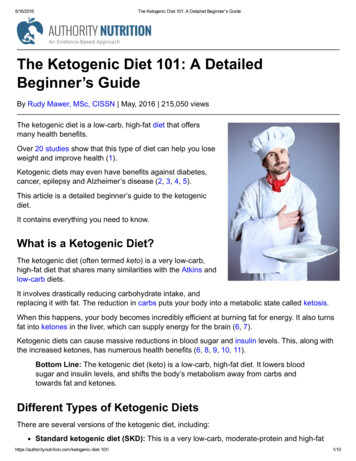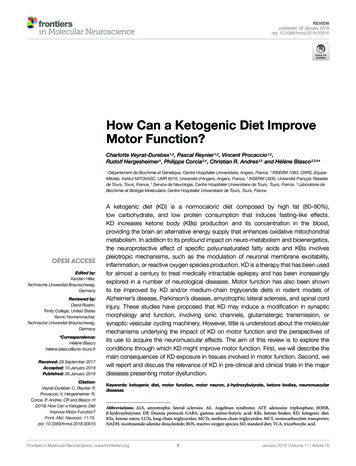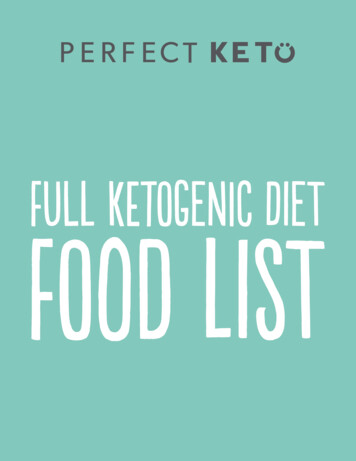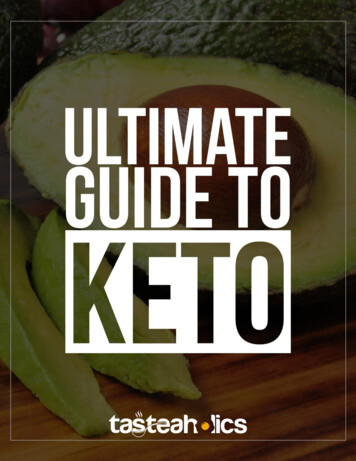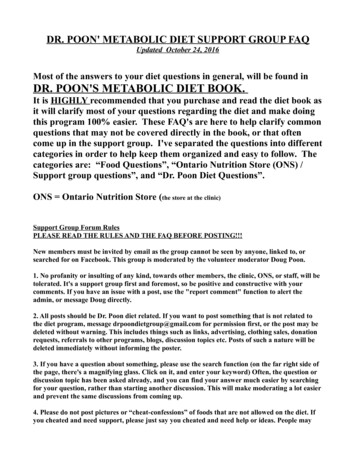
Transcription
TheWicked GoodPYKetogenicREVIEWCODiet Cookbook
WIEEVRPYOC
A M A N DA C . H U G H E SWickedStuffed.comTheWicked GoodCOPYKetogenicWDiet CookbookREVIEEasy, Whole Food Keto Recipesfor Any Budget
PYCopyright 2016 by Amanda C. Hughes, Providence, Rhode Island.CONo part of this publication may be reproduced, stored in a retrieval system or transmitted in any formor by any means, electronic, mechanical, photocopying, recording, scanning, or otherwise, except aspermitted under Sections 107 or 108 of the 1976 United States Copyright Act, without the prior writtenpermission of the Publisher. Requests to the Publisher for permission should be addressed to thePermissions Department, Rockridge Press, 918 Parker St, Suite A-12, Berkeley, CA 94710.EVIEWLimit of Liability/Disclaimer of Warranty: The Publisher and the author make no representations orwarranties with respect to the accuracy or completeness of the contents of this work and specificallydisclaim all warranties, including without limitation warranties of fitness for a particular purpose. Nowarranty may be created or extended by sales or promotional materials. The advice and strategiescontained herein may not be suitable for every situation. This work is sold with the understanding thatthe publisher is not engaged in rendering medical, legal, or other professional advice or services. Ifprofessional assistance is required, the services of a competent professional person should be sought.Neither the Publisher nor the author shall be liable for damages arising herefrom. The fact that an individual, organization, or website is referred to in this work as a citation and/or potential source of furtherinformation does not mean that the author or the Publisher endorses the information the individual,organization, or website may provide or recommendations they/it may make. Further, readers should beaware that Internet websites listed in this work may have changed or disappeared between when thiswork was written and when it is read.For general information on our other products and services or to obtain technical support, pleasecontact our Customer Care Department within the US at (866) 744-2665, or outside the US at(510) 253-0500.RRockridge Press publishes its books in a variety of electronic and print formats. Some content thatappears in print may not be available in electronic books, and vice versa.Trademarks: Rockridge Press and the Rockridge Press logo are trademarks or registered trademarks ofCallisto Media Inc. and/or its affiliates, in the United States and other countries, and may not be usedwithout written permission. All other trademarks are the property of their respective owners. RockridgePress is not associated with any product or vendor mentioned in this book.Photo credits: Stocksy/Nadine Greeff, Cover; Stockfood/Mick Jones, p.2; Stockfood/Helen Cathcart, p.6;Stocksy/Darren Muir, p.9; Stockfood/Victoria Firmston, p.10; Stocksy/Laura Adani, p.28; Stocksy/Ina Peters,p.28; Stockfood/Mona Binner, p.82; Stockfood/Jalag/Schuerle Grossmann, p.100; Stocksy/Jeff Wasserman,p.124; Stockfood/Andre Baranowski, p.170; Stockfood/Gräfe & Unzer Verlag/Joerg Lehmann, p.194; Stockfood/The Stepford Husband, p.214; Stockfood/Noel Barnhurst, p.236; Stockfood/Gräfe & Unzer Verlag/JoergLehmann, Backcover; Stockfood/Andre Baranowski, BackcoverISBN: Print 978-1-1-62315-734-0 eBook 978-1-62315-735-7
PYOREVIEWCTo Patrick, my partner in love, life, and ketosis.And to my goldendoodle Napa, who doesn’t mindcleaning up our leftovers.
WIEEVRPYOC
ContentsIntroduction 8CHAPTER 5CHAPTER 10The Whole FoodKetogenic Lifestyle 11Salads, Side Dishes& Zoodles 83Desserts 195OPYCHAPTER 1CHAPTER 6Fish & Shellfish 101CHAPTER 3IEWCCHAPTER 2Breakfast 29Beef & Lamb 125REVDrinks, Shakes& Smoothies 49CHAPTER 7CHAPTER 11Rubs, Condiments &Sauces 215Acknowledgments 237Appendix A:A 4-Week Meal Plan 238Appendix B:The Dirty Dozen and theClean Fifteen 246Appendix C:Conversion Tables 247CHAPTER 4CHAPTER 8Snacks 65Pork 149Resources 248References 249Recipe Index 250Index 253CHAPTER 9Chicken 171
IntroductionFor most people, ice cream is the cure-all that can mend a badday, a broken heart, and a sunburn. While chocolate-chipcookie-dough ice cream has been there for me through thickand thin, it’s the ketogenic diet that has saved me from bigger issues,PYlike being overweight, having chronic vertigo, and feeling the type ofanxiety where it always feels like the room is spinning.In 2010, my now husband learned about the ketogenic diet throughOsocial media. When he described the diet, where fat and protein arethe primary components, I told him he was crazy. How could anyoneCsurvive without spaghetti or macaroni and cheese? What about cake?When he said he was going to try it, I begged him not to and told himthat I’d never forgive him if he dropped dead from a heart attack fromWthis crazy bacon and butter diet.Thankfully for both of us, he was patient with my clear over-IEreaction and, instead, started sending me articles on the benefits ofa ketogenic diet for a variety of health issues. When I read the partsabout reduced anxiety, I was intrigued. But when I learned how theEVreduction of sugar in your body could starve cancer, I willingly did myown research. Fast-forward to today, and I’ve lost almost a hundredpounds (most of it in the first few years, with more still to go), and myRvertigo is virtually nonexistent. I sleep great at night, wake up early,have energy throughout the day, am mentally clear instead of in aconstant brain fog, and feel like a new person. My cholesterol levelsare as good as they’ve ever been, and my triglycerides are cut in half.The ketogenic diet was and still is the only “diet” I’ve been on. I liketo think of it as more of a lifestyle change because it truly does touchall parts of my life—and changed the way I live.8
I’ve spent the last several years developing awhole food–focused approach to the ketogenicdiet for myself. If you’re putting all this worknot use the healthiest ingredients you can?It’s for this reason you’ll find that myproducts, even sweeteners like erythritolOrecipes are less likely to use typical “low-carb”PYinto losing weight and getting healthy, whyand stevia, unless necessary, and why I often recommend organicCvegetables and grass-fed beef. By all means substitute conventionalingredients to stay within your budget, but, when you have the option,go for organic veggies that don’t use pesticides, and grass-fed beef,Wwhich has abundant healthy, anti-inflammatory omega-3s. “Organic”isn’t a marketing word; it distinguishes high-quality ingredients.IE(“All-natural” and “artisan,” on the other hand, aren’t regulateddesignations and are purely marketing terms.)For many years I’ve shared my whole food recipes with otherEVketoers on my blog, WickedStuffed.com, and together we’ve comeup with new and creative ways to approach meals that don’t includebread, sugar, and other additives. In this book, you’ll find the results ofRyears of experimenting with new flavors and ingredients. My recipesare usually simple and include pantry staples, but I’ll also introduceyou to some of my favorite keto ingredients like ghee, burrata, andpink Himalayan salt. I hope you have as much fun preparing—andeating—the recipes in this book as I did creating them.INTRODUC TION9
WIEEVRPYOC
CHAPTER ONECOPYTHE WHOLE FOODKETOGENIC LIFESTYLEREVIEWThe ketogenic diet can be as simple or as complicated as you makeit. In its simplest form, it can be described as staying in ketosis.Ketosis is the process by which your body creates ketones for energyin the absence of carbohydrates. Cave people didn’t indulge in boxesof mini brownies; they got their energy from vegetables, berries,and meat. To get in and stay in ketosis, most ketoers start by eatingfewer than 20 net carbohydrates per day. Ketogenic dieters alsotry to keep their daily macronutrient intake (or “macros”) at about10 percent carbs, 20 percent protein, and 70 percent fats. You’ll seethis is easier than you think. Once you determine how many carbsyou can consume before kicking yourself out of ketosis, you may findyou can raise the bar from 20 to 50 net carbohydrates per day.11
Back when men and women foraged for food, they hunted birds andanimals, caught fish, and snagged fruits and berries off plants. With thediscovery and refinement of sugar, energy could suddenly be producedfrom carbohydrates, which are easy to process and turn into energy.However, they also burn off—and are thus wasted—just as quickly.Before humans began ingesting refined sugar and carbohydrates,we were always in ketosis. Paleo advocates suggest that back then,our bodies were fueled by ketones for energy and burned fat for fuel.Even today, significant amounts of carbohydrates aren’t needed. InPYfact, according to a 2002 study published in the Journal of Pediatrics,babies are born in ketosis and stay that way for as long as they’rebreastfeeding. This also happens to be the time when babies’ brainsare growing at a tremendous rate. You may not feel hungry whileOin ketosis because your food is digested and energy is burned moreslowly. Basically, you’re getting more bang for your food buck.CThe ketogenic diet was not developed for weight loss, but as a veryreal remedy for patients with epilepsy, and it is recommended by theWEpilepsy Foundation. But, according to a 2004 study published in theJournal of the International Society of Sports Nutrition, a ketogenic dietdoes support weight loss. Indeed, many weight-loss diets, includingIEAtkins, were built upon its principles. The South Beach diet is a lowcarb diet, but its goal is to keep you slightly out of ketosis. Paleo canEVbe considered ketogenic, but anyone consuming honey and quinoa isnot likely in ketosis either. In some ways you could call the ketogenicdiet the blueprint for all low-carb diets. People have used it success-Rfully for weight loss, but also for reducing anxiety and increasingenergy and mental clarity. In addition, a 2013 study published in theEuropean Journal of Clinical Nutrition showed that it may even help prevent acne, Parkinson’s disease, multiple sclerosis, and cancer.No matter your journey, the recipes in this book are ketogeniccompliant—meaning they are naturally low in carbs—and may helpwith one, or all, of the preceding ailments. And your belly will feelfull all the while!12TH E WICKED GOOD KE TOG ENIC DIE T COOKBOOK
Keto NutritionThe ketogenic diet is simple in its implementation (goal: stay in ketosis);however, the path can be different for each person. Everyone begins at20 net carbohydrates and then, over time, determines how many theycan consume without being kicked out of ketosis. I’ve eaten as muchas 75 net carbs in a day and stayed in ketosis (it was Disney World,there was funnel cake, enough said) while my husband, who stuck tohis diet and had two bites, was kicked out of ketosis. Everyone is dif-PYferent, of course. It’s up to each of us to learn what our personal “kickout” point is and stay below it.How do you know if you are in ketosis? Simple: keto sticks. Tubes ofthese thin test strips are available at your local pharmacy. Simply uri-Onate on a stick to find out if you’re in or out of ketosis. If the stick turnslight pink, you’re out of ketosis; any shade of purple means you’re in.CNote that a darker shade of purple does not indicate “better” ketosis—itmatters only if you are in or out, burning fat or not. There aren’t tiers orWlevels you need to reach. However, if you’re diabetic, you run the risk ofa condition called ketoacidosis on a ketogenic diet. Be sure to talk withyour doctor about the diet; he or she will likely recommend using ketoIEsticks and making sure you stay in the light purple range.To calculate net carbohydrates, take the number of carbohydratesEVyou consume and subtract the number of fiber grams consumed. Thisis the number you’ll use to track your daily total. When food is highin fiber, like coconut, you can eat more of it even if the carbohydrateRnumbers look a little scary.When I refer to macros, I’m talking about the balance of foods youeat in a day as they fall into one of the three main macronutrientcategories: carbohydrates, proteins, and fat. Some people on the ketodiet find that these percentages are helpful for keeping track of theirweight loss, and other people use them for medical reasons. If youdon’t have any medical reasons to stick to certain percentages, thenI think a good daily starting point for the ketogenic diet is 10 percentThe Whole Food Ketogenic Lifestyle13
carbs, 20 percent proteins, and 70 percent fats. If this doesn’t keep youin ketosis, try 5 percent carbs, 15 percent proteins, and 80 percent fats.Ultimately, it’s up to you to find the balance that works best for you.There are hundreds of calculators online that you can use to inputyour stats, such as weight, height, sex, weight goal, and so on, and thecalculator will tell you what is supposed to be the ideal macro for you.The amount of carbs (which should generally come from vegetables)or fats that will create ketosis in the body varies for different people.It is certainly not an exact science.PYFor the recipes in this book, the macro percentages were calculatedby taking the number of grams of each macro and multiplying it bythe number of calories per gram (9 calories for 1 gram of fat, 4 calories for 1 gram of carbs or proteins) and then dividing that by the totalOnumber of calories per serving. For example, imagine a dish that hasCthe following nutritional information per serving:Calories: 184; Total Fat: 14g; Saturated Fat: 6g; Cholesterol: 224mg;WCarbohydrates: 2g; Fiber: 1g; Net Carbs: 1g; Protein: 12gTo determine how much of a serving’s calories come from fat:IE(14 grams of fat) (9 calories per gram of fat) 126 calories from fat(126 calories from fat per serving) (184 total calories per serving) 68.5%EVTo determine how much of a serving’s calories come from total carbs (not net carbs):(2 grams of carbs) (4 calories per gram of carb) 8 calories from carbs(8 calories from carbs per serving) (184 total calories per serving) 4%RTo determine how much of a serving’s calories come from protein:(12 grams of protein) (4 calories per gram of protein) 48 calories from protein(48 calories from protein per serving) (184 total calories per serving) 26%14TH E WICKED GOOD KE TOG ENIC DIE T COOKBOOK
KETO VERSUS PALEOTo follow a strict ketogenic diet, you will need to consume no morethan 20 net carbohydrates a day (most Americans eat closer to 300).While no foods are off-limits, many ketoers choose not to eat sugar,bread, and grains. Their carbs come instead from whole foods likevegetables. Proteins are also consumed, but healthy fats make upmuch of the meal plans.The paleo diet is meant to mimic the diet of early humans, which didPYnot include refined sugars, grains, and dairy. The idea is that the foodsof our early ancestors—protein, vegetables, and fruits—provided allthe necessary nutrients and energy. The sugars, grains, and dairy weOconsume today are linked to food allergies and intolerances, as wellas the increase in celiac disease, diabetes, and lactose intolerance,Camong other ailments.While the paleo diet can often be ketogenic, the ketogenic diet is notnecessarily paleo. The keto diet doesn’t preclude certain foods—youWsimply won’t want to waste your carbs on them. The goal of the ketodiet is only to stay in ketosis, so any of these foods at low levels likelyIEwon’t kick you out. These same principles apply to the recipes in thisbook. You won’t find any grains or sugars here, but you’ll find plentyof dairy—delicious, wonderful dairy. However, if you’re going the paleoEVroute, keep an eye out for my “Make it paleo” tips, which are providedRwherever possible.The Whole Food Ketogenic Lifestyle15
Every meal you eat doesn’t need to follow these macros; you makea tally at the end of the day. This allows you to eat a dish of vegetablessautéed in ghee without the need to throw in pancetta (unless youwant to).As you consult the macros for each recipe in this book, be awarethat there’s variation among different ingredients. For example,organic heavy cream may have less than 1 net carb, while a nonorganic store brand may have more. Tomato sauce is another trickyone. Some better varieties of marinara come in as low as 4 net carbsPYper ¼ cup because they contain no added sugar, but most mainstreambrands have 15 or more net carbs in that same ¼ cup. To enjoy anItalian fix now and again, I recommend splurging on the good stuff—or making your own sauce.OAlthough the ketogenic diet is not meant to be exclusionary, andyou could certainly get your 20 net carbs each day from a single sliceCof bread, you probably won’t make it far in a ketogenic lifestyle. Yourblood sugar will spike and probably kick you out of ketosis, and itWwon’t be any fun. Try instead some buttery veggies and ooey-gooeyfondue, and that slice of bread won’t be necessary. Just wait and see:IEBefore long you will lose your cravings for bread!EVDiet GuidelinesFollowing are some of the best ways to stay in ketosis and get themost out of your ketogenic experience. These tips will help you sur-Rvive what’s known as “keto flu.” During your first few days, or up to aweek, of ketosis, you may feel a bit tired, sluggish, and dizzy as yourbody adjusts to producing and burning ketones as energy instead ofcarbohydrates. (In the Atkins diet, this period is known as “induction.”)16TH E WICKED GOOD KE TOG ENIC DIE T COOKBOOK
Stick to your macros. The daily 10/20/70 ratio is worth sticking tobecause it works. Too many carbs and you won’t burn fat. Too muchprotein and it won’t burn off if you don’t use it. Not enough fat andyou won’t be full. All these problems add up to less energy. The recommended ratio allows for a whole food approach to ketosis thatincludes alkalizing green veggies, which break down the acids in meat.Keep your electrolytes up. Electrolytes are the minerals in our bloodthat keep us hydrated and keep our nerves and muscles workingproperly in balance. By producing ketones, you’ll be flushing outPYmore electrolytes than usual. This means you should increase yoursalt intake while following keto because your body won’t hang ontosodium like it used to. Most ketoers do this by drinking chicken brothOor bouillon daily, especially in the first few weeks of ketosis while thebody is adjusting. If you feel achy in the first week on keto while goingmagnesium supplements as well.Cthrough carbohydrate withdrawal, bouillon helps. Many ketoers useWDrink lots of water. Drinking water is one of those things that everyone tells you to do, and you don’t take it seriously until you end upIEwith a kidney stone! I promise that drinking two to three liters ofwater every day will make your body feel clean, full, and hydrated;keep your bowels moving; and help you lose weight faster if that’sEVwhat you’re ketoing for.Keep track of what you eat. Measuring what you eat turns any dietinto a game. Use apps like MyFitnessPal to track your meals andRmeasure your macros at the end of the day. There’s also an app calledQuip you can use to make shopping lists. It includes check marks thatallow you to reuse your shopping list every week.The Whole Food Ketogenic Lifestyle17
REMEMBER TO CHECK INGREDIENT LISTS!The following products are often sold with added sugars or fillers, so check labelscarefully before purchasing, and remember to calculate the net carbs by subtractingthe amount of fiber from the total amount of carbohydrates. You need items that arelow in net carbs. The following foods are used often in my recipes, and I’ve listed myfavorite brands, too.PYO7. Frozen hamburgers often use fillersand might carry 3 to 5 carbs per burger,when it would be 0 if you make themyourself from pure ground beef.8. “Sugar-free” does not always translate to low-carb, and “gluten-free”almost never means low-carb. In fact,low-carb isn’t always ketogenic. Youmay find 20 to 30 carbs in a lowcarb bagel!W2. Organic dairy products. Organicheavy (whipping) cream, sour cream,and cream cheese don’t have any carbs,or less than 1 carb. Their nonorganiccounterparts can have 2 or even 3 netcarbs per serving. I like Organic Valley brand.6. Prepared foods offered at yourfavorite grocery store often includesugar and breading that you can’tsee by looking at them.C1. Peanut butter. Many brands havetoo much sugar, so choose a brand thatis low in net carbs. My favorite is theTeddie brand of peanut butter, whichhas only 4 net carbs per serving. Mostorganic peanut butters that containonly peanuts will match or even beatthis number.EVIE3. Tomato sauce. If you pick any tomatosauce off the supermarket shelf, you’llfind it has anywhere from 10 to 20 netcarbs per serving. Stick with one thatdoesn’t have added sugar and containsless than 4 net carbs per serving. Twopopular brands are Mezzetta and Rao’s.R4. Coconut milk is good and fatty, butunsweetened coconut milk has 1 netcarb or less, as compared to 9 or moreper serving for regular coconut milk.5. Whey protein powder can be veryhigh in sugar, but there are many lowand no-carb brands on the market.189. Salad dressings can be loaded withsugar, so look for those with 0 to 1 netcarb per serving.10. Pre-cut cheese, especially American cheese, is often loaded with upto 3 carbs per slice! Stick with organicshredded cheese containing no fillers,and you’ll be left with less than 1 netcarb per serving.11. Deli meat is rarely low-carb. A smallserving of bologna could be 5 carbsor more. When you do indulge indeli meats with fewer carbs (such asturkey, chicken, and ham), buy nitratefree varieties.TH E WICKED GOOD KE TOG ENIC DIE T COOKBOOK
Eat your calories. Don’t try to do a low-calorie ketogenic diet, oryou’ll end up without any fuel. Fat is your new fuel. Without it, you’llnot only be hungry, but you also won’t lose weight. Many ketoers eat1,800 calories or more per day, and I find that eating less actuallymakes me stop losing weight. But don’t overindulge, either. You won’tlikely lose weight eating 5,000 calories a day. The good news is thatyou won’t be hungry enough to eat that much anyway!Stock up on healthy fats. Fat has become a dirty word in our society.But there are plenty of good fats out there. Cook everything inPYghee, which is lactose- and casein-free clarified butter, high in antiinflammatory omega-3 fatty acids. For times when you run out of thismagical golden buttery oil, keep a backup of coconut oil and oliveOoil. Avoid processed oils like vegetable, sunflower seed, soybean, andthe healthy omega-3s in your body.Ccorn—they are high in inflammatory omega-6s, which in turn destroyInvest in certified organic, grass-fed, and free-range products.WI’m not trying to go all crunchy granola on you, but now that your dietis exchanging highly refined carbohydrates for mostly fats and pro-IEteins, you’ll want to pay extra-special attention to the quality of thoseingredients. I’ll identify such ingredients in most of the recipes, and IEVrecommend you buy them if your budget allows.Stick to real food, not low-carb products. If you check the label ofmost low-carb products, unless they’re also paleo products, you’ll beshocked at their ingredients, such as unpronounceable chemical addi-Rtives. You can control what goes into your body by making your ownmeals and sticking to whole foods.The Whole Food Ketogenic Lifestyle19
Foods to EnjoyHigh Fat / Low Carb (based on net carbs)Meats & SeafoodBEEF(ground beef, steak, AWFISHSHRIMPOCTOPUSDUCKVEALOPORKFISHEVCREAM CHEESEGREEK YOGURTR(full-fat)PROVOLONE CHEESEHALLOUMI CHEESEQUESO BLANCOHEAVY (WHIPPING)CREAMRANCH DRESSINGIECOTTAGE CHEESEGRILLING CHEESEWBLUE CHEESEDRESSINGBURRATA CHEESEVENISONC(pork chops, bacon, etc.)Dairy20PYCRABEGGS(without fillers)LOBSTERHOMEMADE WHIPPEDCREAMKEFALOTYRI CHEESEMOZZARELLA CHEESETH E WICKED GOOD KE TOG ENIC DIE T COOKBOOKRICOTTA CHEESEUNSWEETENEDALMOND MILKUNSWEETENEDCOCONUT MILK
Nuts & SeedsALMONDSMACADAMIA NUTSPUMPKIN SEEDSBRAZIL NUTSPEANUTSSACHA INCHI SEEDS(in moderation)CHIA SEEDSSESAME SEEDSPECANSFLAXSEEDWALNUTSPINE CUMBERSBELL PEPPERSGARLICEV(in moderation)HERBSSALAD GREENSJICAMASCALLIONSLEMONSSPAGHETTI SQUASH(in RRIESCAULIFLOWERCHICORYPUMPKINGREEN BEANSIEBROCCOLICARROTSPICKLESWBLUEBERRIES(in moderation)C(in moderation)BLACKBERRIESCABBAGEONIONSOALFALFA SPROUTSPYFruits & VegetablesOLIVESSTRAWBERRIESTOMATOES(in moderation)ZUCCHINIThe Whole Food Ketogenic Lifestyle21
Foods to AvoidLow Fat / High Carb (based on net carbs)Meats & Meat AlternativesDELI MEATSAUSAGE(some, not all)(with fillers)HOT DOGSSEITANTOFUPY(with TNUTSREVIENuts & SeedsW(sweetened)CSOY MILKCOCONUT MILKCASHEWSYOGURTOALMOND MILK22TH E WICKED GOOD KE TOG ENIC DIE T COOKBOOKPISTACHIOS
Fruits & MAMEBEANSEGGPLANTEVBUTTERNUT BERRIESSWEET POTATOESGOOSEBERRIESTARO ROOTIEBOYSENBERRIESBURDOCK ROOTPLUMSW(all EW MELONWATER CHESTNUTSHUCKLEBERRIESWINTER SQUASHKIWISYAMSRCHICKPEASThe Whole Food Ketogenic Lifestyle23
Ten Tips for Keeping Keto Costs DownPaying higher prices for grass-fed, free-range, organic foods buysyou peace of mind on the ketogenic diet. These types of products aregenerally higher in good fatty acids and lower in not-so-great ones.If you’re splurging on high-quality products, here’s how you can cutcosts elsewhere.COPY1. Buy from a butcher or local farmer. Butcher shops tend to be lessexpensive than most supermarkets, and you can also get excellent,less-costly cuts like the lesser-known tri-tip. If you’re cooking for thewhole family or simply want lots of leftovers, make the slow cookeryour friend and take advantage of roasts instead of single cuts ofmeat. If you have ample freezer space, consider buying a whole cow—seriously. Many farmers sell whole, half, or quarter cows and willbutcher the meat and vacuum-seal every cut for you.IEW2. Shop every week. When you come home to an empty fridge,it’s hard to resist the urge to dine out or order in. But to do so whilefollowing a ketogenic diet usually means you’re getting a cheap salador an expensive steak, and nobody ever goes for the salad whenthey’re hungry after a long day. A well-stocked fridge translates tonutritious meals for far less money than eating out.REV3. Create a meal plan. On the ketogenic diet, you won’t need mostdried and packaged goods. Instead, you’ll be buying a lot of fresh produce, meats, and dairy products that don’t have a very long shelf life.Plan a week’s worth of meals, along with a shopping list, and avoidveering from that list. By following a plan and a list, you’ll avoid wasting food by buying only what you need.4. Shop the sales and cheaper cuts of meat. You don’t need to eatgrass-fed ribeye steaks every day. If beef isn’t on sale, look for lessexpensive options like chicken legs or pork chops. You can easily feeda family of four for under 5 if you buy meat on sale.24TH E WICKED GOOD KE TOG ENIC DIE T COOKBOOK
5. Splurge on the essentials now. Buy staples like ghee, coconut oil,pink Himalayan salt (if you can find it), Maldon sea salt, and driedherbs and spices in bulk from discount outlets. Your pantry will bewell stocked, and your week-to-week grocery bill won’t get blown upwith tiny 15 jars of coconut oil at the grocery store. Most of theseproducts have long shelf lives, and a little goes a long way, so it will bea while before you need to restock.COPY6. Make your own. Lots of recipes call for chicken broth. Next timeyou roast a chicken, make your own bone broth (see the recipe onpage 193). Strain the broth through cheesecloth and freeze individualportions for future recipes. Instead of buying fresh herbs every week,make herbal ice cubes. Mince fresh herb(s) and pack them into icecube trays so that each cube is about 3/4 full. Fill the trays with boilingwater to blanch the herbs and put them in the freezer. Pop the icecubes out when they're frozen and store them in freezer bags.W7. Invest in a vacuum sealer. When you buy meat in bulk, makeit last longer with a vacuum sealer. I even marinate my meats withspices and herbs (but not salt) before freezing.EVIE8. Focus on cheaper ingredients. A whole food approach to theketogenic diet doesn’t mean meat every night. Tuna salad on romainelettuce leaves, or slices of tomato and mozzarella drizzled withherbs, olive oil, and balsamic vinegar is far more budget friendlyand equally delicious.R9. Buy in season. Imported strawberries are expensive in December,but in the summer you can get them at even the most expensive farmstand for under 3 a container. Buy in season and save on the fruitsand vegetables that are abundant at different times of the year.10. Make recipes with fewer ingredients. I’ve tried to eliminateunnecessary ingredients, like an herb garnish, unless it serves a culinary purpose other than looking pretty. (Fresh herbs are indeed lovely,but often only a small amount is needed. Freeze the remaining herbsThe Whole Food Ketogenic Lifestyle25
in some water in an ice cube tray, or in a tightly packed and sealedplastic bag.) You can cherry-pick the recipes you make based on theingredients required. Ingredients that tend to increase the cost of arecipe include fresh herbs, fancy cheeses, and wine.The RecipesThe ketogenic recipes in this book are as close as we can get to a wholePYfood approach to keto while still keeping it delicious every step of theway. Always pay close attention to the nutrition labels on any packagedfoods to make sure you’re choosing those with no added sugars or fillers. When I’ve inc
12 THE WICKED GOOD KETOGENIC DIET COOKBOOK REVIEW COPY. Keto Nutrition The ketogenic diet is simple in its implementation (goal: stay in ketosis); however, the path can be different for each person. Everyone begins at 20 net ca
